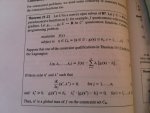Hi,
My questions pertains to the assumptions that are made with regard to finding a global maximum when we have a pseudoconcave function defined on a convex open subset of Rn. The related theorem is attached as an image. My question follows;
We usually make a non-degenerate constraint qualification, NDCQ (gradient of the constraint is not equal to zero) in order for the first order condition of the lagrangian to exist. However, in this theorem, both assumptions about the existence of NDCQ and the first order conditions are made explicitly. Why is that?
Thanks in advance for your help!
My questions pertains to the assumptions that are made with regard to finding a global maximum when we have a pseudoconcave function defined on a convex open subset of Rn. The related theorem is attached as an image. My question follows;
We usually make a non-degenerate constraint qualification, NDCQ (gradient of the constraint is not equal to zero) in order for the first order condition of the lagrangian to exist. However, in this theorem, both assumptions about the existence of NDCQ and the first order conditions are made explicitly. Why is that?
Thanks in advance for your help!

